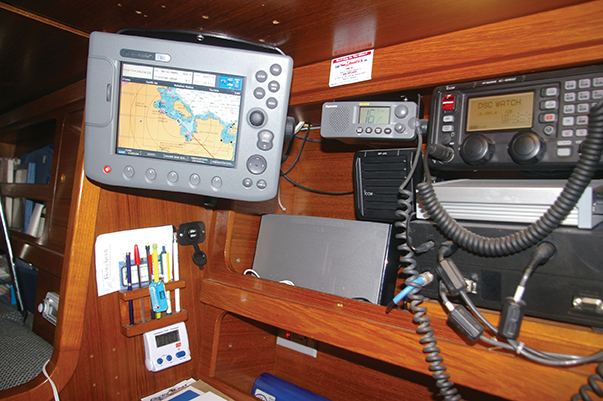Getting your crew comfortable using the VHF radio (published February 2015)
One of the simplest yet most important pieces of electronics aboard your cruising boat is the VHF radio. Able to put you in touch with marinas, bridges, ships, other vessels and emergency services, the VHF is a valuable piece of communication equipment that should always be kept in good working order. It is truly indispensible.
Because of VHFs versatile and important role aboard, it is imparative that every crew member have at least a working knowledge of how to operate it and what to do in the event of an emergency. Any crewmember who regularly sails aboard your boat should be completely comfortable performing a radio check, hailing a bridge or simply calling another vessel on the other side of the anchorage. It’s these skills and an overall awareness of the unit that could potentially payoff in the event of an emergency.
Before getting underway, give novice sailors or those unfamiliar with the VHF a quick rundown of how to operate the radio. Do a radio check with them and explain the emergency, working and hailing channels, and talk about common VHF mistakes such as talking too fast or not un-keying the mic after broadcasting.
For regular crew such as spouses, or children who are mature enough to handle communications duties, get them comfortable by calling other boats they are familiar with, have them do radio checks each day, or put them in charge of checking in on a marina’s or cruising area’s radio net. In the end, the people you sail with the most should be just as comfortable using the VHF as they are making calls on their cell phone.
Following is a helpful list of VHF protocols and procedures. Use it to help familiarize your crew with operating the radio when they come aboard. Simply fill out your vessel name and MMSI number in the appropriate spots and make any notes that are specific to your boat or sailing area.
VHF RADIO PROCEDURES
for S/V ___________________MMSI #:______________
ALWAYS MONITOR CHANNEL 16
Conduct a Radio Check: Use channel 9 or 16 and say, “Can I get a radio check please.” Un-key mic and wait for a response. Or, use Sea Tow’s Automated Radio Check service on channel 24, 25, 26, 27 or 28 (depending on your area) and wait to hear the playback of your message.
Hail a Commercial Vessel: Use channel 13 and say, “Ship name, Ship name, Ship name, this is the sailing vessel __________. Over.” Un-key mic and wait for a response. Have your conversation and then switch back to channel 16 by saying, “__________ standing by on one six. Out.”
Hail a Bridge: Use channel 13 (or other specifically designated channel) and say, “Bridge name, bridge name, bridge name, this is the sailing vessel __________. Over.” Un-key mic and wait for a response. Have your conversation and then switch back to channel 16 by saying, “__________ standing by on one six. Out.”
Hail Another Boat: When contacting another recreational vessel, hail them on channel 9 or 16 and then switch to channel 67, 68, 69, 71, 72 or 78a to have your conversation. Say, “Boat name, boat name, boat name, this is the sailing vessel__________. Over.” Un-key mic and wait for a response. Then say, “Boat name. Let’s go up to six eight. Over.” Un-key mic and wait for a response. Switch to the channel you agreed upon to have your conversation and then switch back to channel 16 by saying, “__________ standing by on one six. Out.”
Make a Distress Call (Mayday, Pan Pan, Securité): Always use channel 16 for distress. Mayday is only used when there is an imminent threat to life or property. Pan Pan (pronounced pahn-pahn) is an urgent call indicating that you are in trouble but are not in need of immediate assistance. A Securité (pronounced see-cure-ah-tay) call is used when you are trying to convey a navigational or safety concern to other mariners (i.e. reporting a log in the water or that a buoy is no longer lit or on station).
U.S. Coast Guard steps for making a distress call: “MAYDAY, MAYDAY, MAYDAY, this is __________, __________, __________. MAYDAY, _________.”
“My position is (latitude, longitude or give any other well-known landmark. Include any information on vessel movement such as course, speed and destination.) Give the nature of distress (sinking, fire etc.), kind of assistance desired and number of persons onboard plus any other information that might help with rescue such as length or tonnage of vessel, number of persons needing medical attention, hull color, etc.
Then, “Over.” Un-key mic.
DSC for Distress: To make a distress call through the Digital Selective Calling (DSC) service use channel 70.
Notes:________________________________________________________________________________

















